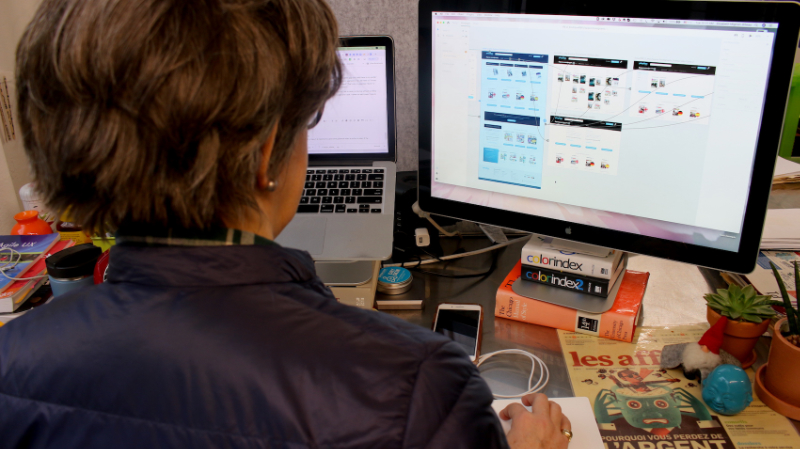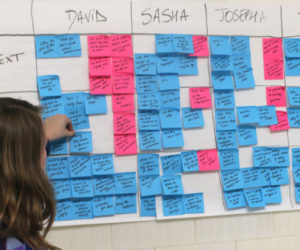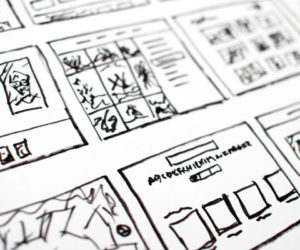What a couple of days we’ve had in this design sprint workshop!
After defining the challenge and creating solutions, we’re now going to get our hands dirty building a high-fidelity prototype to test on the last day of the design sprint workshop.
That’s right, on this third day of the workshop, we’re creating a prototype to test with five real users. That’s it.
(Of course, we’ll also take the time to finalize recruitment for tomorrow’s test.)

A challenging task ahead
Yes, the end is in sight.
We’ll get there if you can refrain from tinkering with your chosen solution. Can you do that?
You think I’m joking, but the main risk you face today is walking back on what has already been decided. It’s very tempting, but don’t do it. You’ll thank me later.
Why not?
“The speed at which you must create a prototype is a real challenge in itself,” explains Jeff Mignon, Pentalog’s Chief of Growth.
“In a single day, you have to build six to eight pages that your testers will believe are the real thing.”
Even if you late, it’s a challenge. Let’s not ruin everything by muddling the waters.
Do we agree? Great, let’s start.
What type of prototype are we building?
In this article, we’ll be discussing how we build a high-fidelity prototype for a digital product, a SaaS, for example.
What we are trying to achieve is a product that is so similar to the real thing that testers will believe it is.
If we’re building the prototype for a signup sequence, for example, we’ll make sure the prototype looks real enough that the response you get from testers is meaningful.
In a word, you don’t want a lousy prototype to get in the way of getting reliable feedback on your solution.
Who’s working on the prototype?
That’s an appropriate question because you don’t need every team member to show up for that third day.
First, you’ll need someone who has the skills to build the prototype. At Pentalog, we have figured out that most of our clients don’t have someone with the appropriate skills.
That’s why we provide a senior prototyper who has the experience and the depth to create an effective prototype in what is a very short time.
Because time is tight, we also provide a more junior prototyper to take care of the less critical pages.
And I don’t mean a “ real junior” prototyper, because the time constraints don’t allow for any learning on the job!
We want someone experienced but not as much as the lead prototyper.
Are team members from the client-side participating?
Yes, of course.
We want at least two persons from the client-side who participated in the first two days of the design sprint workshop. It can be more than two, but you need at least that number to work with the prototypers.
Who should you choose? Those who know the product the best.
Should the decider be there? He or she could be, but today’s not about making decisions. Remember: we’re not reconsidering the decision taken yesterday.
Today’s about moving forward and building a workable prototype.
Where do we start?
The folks at AJ&Smart will tell you to start by building the first and last pages of your solution sketches.
In our experience, the first page is often a search results page or some other not so crucial or different page. It’s not that the first page is not important, but it’s most likely a common step where there’s nothing to gain within the parameters of this test.
Instead, we think you should identify the three of four main pages, the ones that you believe will have the most impact on the users – and the results.
The last page is certainly a crucial one because that’s where the main conversion is likely to take place.
So, where do we start? With the most crucial three or four pages. These are the pages that need to be finished by the end of the day.
The lead prototyper will be working on these pages while the more junior prototyper will sweat on the others.
And the clients’ people? They’ll be helping the prototypers, providing immediate feedback and background information on the product or the customers.
What tools do we use?
Any number of tools can do the job. At Pentalog, we like to work with Adobe XD, and we know that tool inside out.
We also like to prototype with Axure RP Pro.
But you could use Sketch or whatever tool you know and feel comfortable with.
The goal is to arrive at a high-fidelity prototype before the end of the day. So leave aside any tool that will require you to go through tutorials on the spot!
Have a writer on the team
If the goal of the prototype is to feel so real that testers will react naturally to it, you need someone who can write good copy.
Jake Knapp, the author of the book Sprint, thinks this role is crucial for the success of the prototype:
“Every sprint team needs a Writer, and it’s one of the most important roles. […] We talked about the importance of words in your sketches. And […] we told you that your prototype must appear real. It’s impossible to make a realistic prototype with unrealistic text. A dedicated Writer becomes extra important if you work in a scientific, technical, or other specialized industry.”
Meanwhile
While the prototypers work on the six to eight pages, someone must confirm that you’ll have at least seven testers ready for the next day.
Why seven? Only five of the selected persons will actually do the tests. But you need at least five, so recruit seven, and you’ll have a couple of backup testers, in case something goes wrong with one of them.
Another crucial task: someone must test the technical stuff. The last thing you need is technical problems when you should be moving fast through the tests and the interviews.
Ready?
At some point, you might decide that it’s getting too late to complete all the pages. Just make sure you can use the crucial ones before you leave for the night.
Since you’re probably going to finish working late, you might want to take a beer to decompress afterward. Or not, because the fourth day is going to be equally intensive and exhausting.
You’ve been warned.
See you tomorrow.
What’s your challenge? Talk to us!
The Design Sprint Workshop series:
The Design Sprint Workshop: Defining the Challenge (Part 1)
The Design Sprint Workshop: Creating Solutions (Part 2)
The Design Sprint Workshop: Voting Day (Part 3)
The Design Sprint Workshop: The Storyboard (Part 4)
The Design Sprint Workshop: Prototyping (Part 5)
The Design Sprint Workshop: Testing (Part 6)


 (3 votes, average: 3.67 out of 5)
(3 votes, average: 3.67 out of 5)






